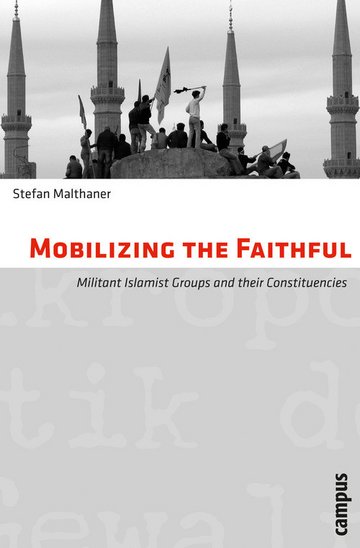| Contents | 6 |
| Acknowledgements | 10 |
| 1. Introduction | 12 |
| 1.1 Militant Islamist groups and their constituencies in social science research | 16 |
| 1.2 Research question and design of this study | 25 |
| 1.3 The case studies and criteria for comparison | 26 |
| 1.4 Central concepts | 28 |
| 1.5 Research strategies, methods, and sources | 31 |
| 1.6 The structure of this book | 37 |
| 2. Violent insurgencies and relationships of support: Outlines of an analytical framework | 39 |
| 2.1 Engaging in relationships: Forms of orientation and reference groups | 40 |
| 2.2 Support relationships: Setting and basic forms | 43 |
| 2.3 Forms of influence in relationships of support | 52 |
| 2.4 Summary | 56 |
| 3. Between Islamic revolution and resistance: The militant groups’ aims and perspectives | 57 |
| 3.1 Killing the Pharaoh, creating an Islamic society: Al-Jamaa al-Islamiyya and al-Jihad in Egypt | 58 |
| 3.2 Resistance against occupation and the Islamic revolution in Lebanon: Hizbullah | 78 |
| 3.3 Summary: Aims and patterns of orientation | 94 |
| 4. The setting: Militant Islamist groups and their social environment | 96 |
| 4.1 Al-Jamaa al-Islamiyya: Rebellion in the Sa’id and Cairo’s shantytowns | 97 |
| 4.2 Hizbullah: Insurgency in South Lebanon, ruling the suburbs | 109 |
| 4.3 Summary | 117 |
| 5. Support relationships I: Al-Jamaa al-Islamiyya – Spreading the Call and ruling the neighborhood | 119 |
| 5.1 “They were just good Muslims”: Support for the Islamist movement and al-Jamaa al-Islamiyya in Ayn Shams | 120 |
| 5.2 Al-Jamaa al-Islamiyya in Imbaba: “Ruling” the neighborhood | 128 |
| 5.3 Establishing a following at the university and beyond: Al-Jamaa al-Islamiyya in Assiut | 132 |
| 5.4 Breaking with the past: Family relationships and al-Jamaa al-Islamiyya | 137 |
| 5.5 Al-Jihad: Preparing clandestinely for a coup d’état | 141 |
| 5.6 Summary: Relationships of support between al-Jamaa al-Islamiyya and its constituency | 142 |
| 6. Development patterns I: Al-Jamaa al-Islamiyya – Escalation, estrangement, and radicalization | 145 |
| 6.1 Fragmentation under pressure: The development of support relationships in Ayn Shams and Imbaba | 146 |
| 6.2 Losing ground: Al-Jamaa al-Islamiyya’s insurgency in Assiut | 151 |
| 6.3 The war against collaborators: Al-Jamaa al-Islamiyya in al-Minya | 160 |
| 6.4 From ambushes to massacres: Decline of the insurgency and loss of constraints on violent practices | 165 |
| 6.5 From ambivalence to condemnation: Al-Jamaa al-Islamiyya and their audiences in public discourse | 168 |
| 6.6 The development of al-Jihad | 170 |
| 6.7 Summary: Dynamics of estrangement and fragmentation | 172 |
| 7. Support Relationships II: Outcast, defender, provider – Hizbullah and the Shiite community in Lebanon | 175 |
| 7.1 Building a movement and providing for the neighborhood: Hizbullah in the southern suburbs of Beirut | 176 |
| 7.2 Reigning in the clans: Hizbullah in the Beqaa | 183 |
| 7.3 Becoming part of the community: The Islamic Resistance in South Lebanon | 186 |
| 7.4 Joining a subculture and an army: Becoming a member of Hizbullah | 196 |
| 7.5 Summary: Relationships of support between Hizbullah and the Shiite community in Lebanon | 199 |
| 8. Development Patterns II: Hizbullah – Resilience, adaptation, and consolidation of support | 202 |
| 8.1 Support for the “resistance” and its resilience under pressure | 203 |
| 8.2 Bringing Iran to Lebanon and “wasting” the community’s sons: Elements of controversy and friction | 205 |
| 8.3 Adaptation and strategic re-orientation: Hizbullah’s response to opposition and weakening support | 212 |
| 8.4 Consolidation of support and control | 219 |
| 8.5 Summary: Dynamics of support, adaptation, and control | 231 |
| 9. Conclusion: Militant Islamist groups and their constituencies – Relationships of support and control | 233 |
| 9.1 Relationship structures: Forms of reference, ties of support, and forms of influence | 234 |
| 9.2 Development Patterns | 247 |
| 9.3 Militant groups and their constituencies: The logic of relational analysis | 256 |
| 10. List of maps and tables | 261 |
| 11. References | 262 |
















